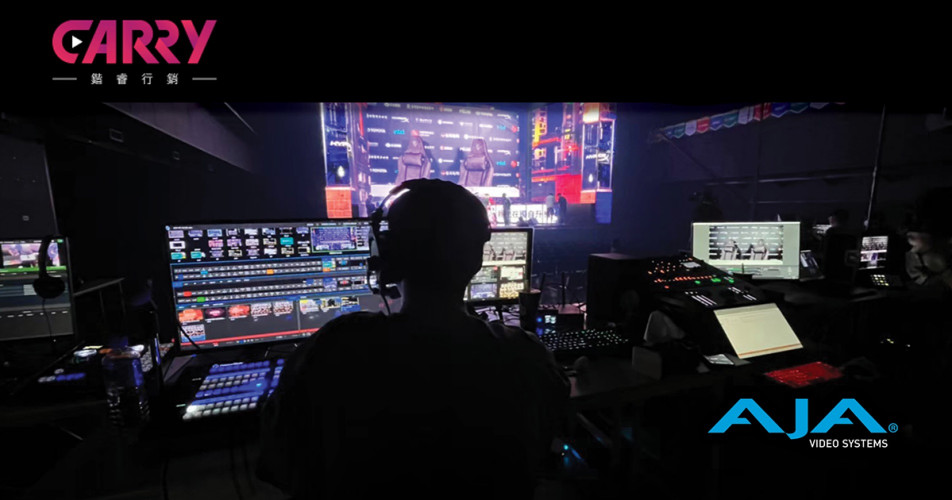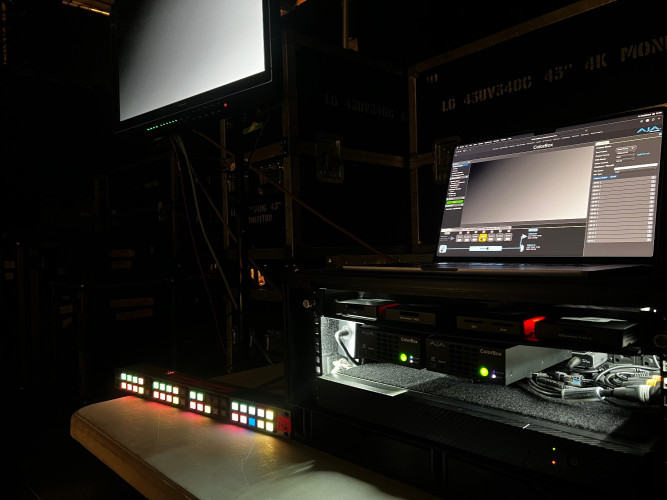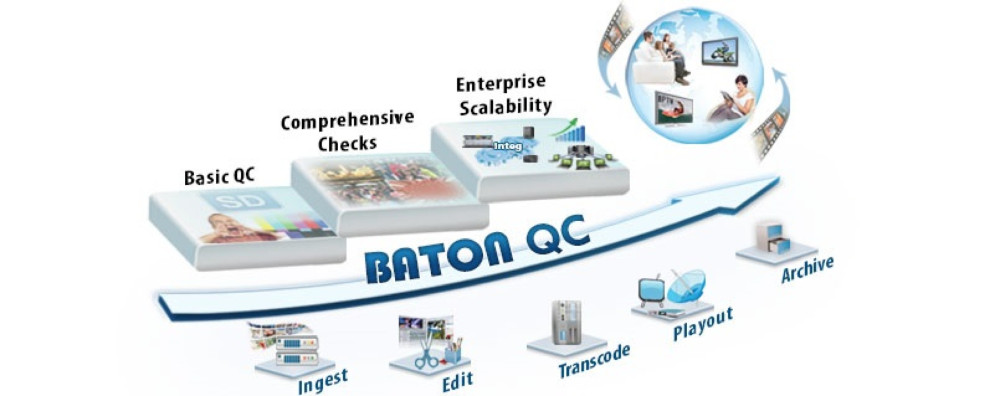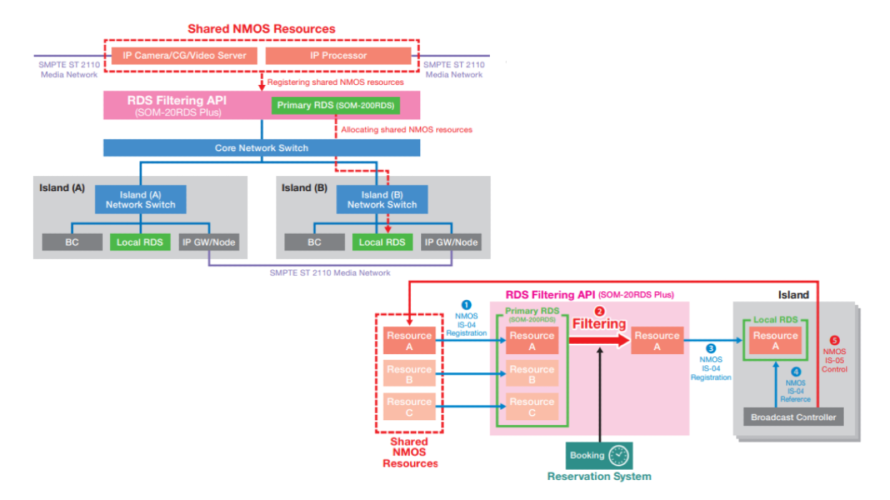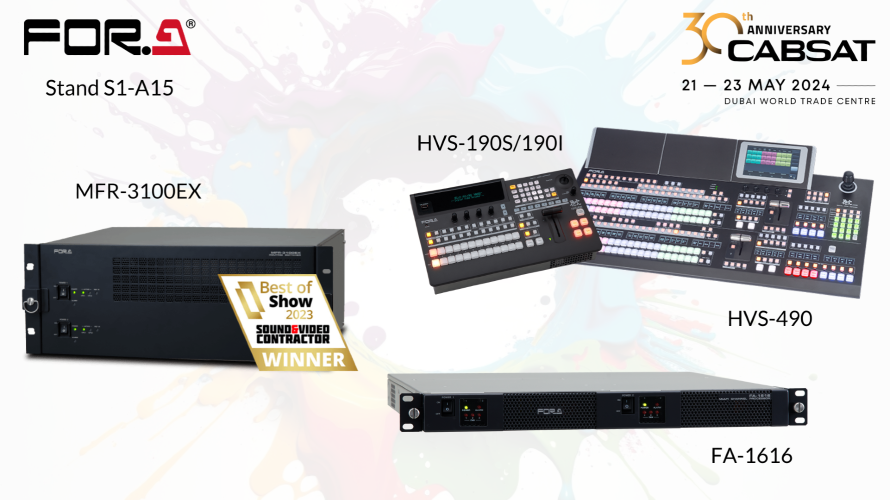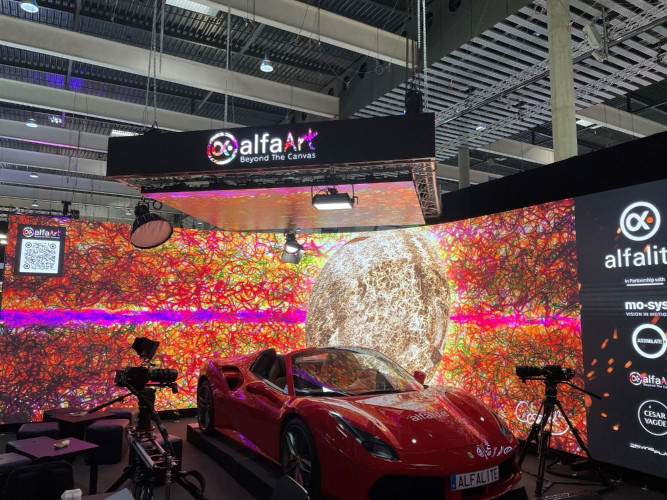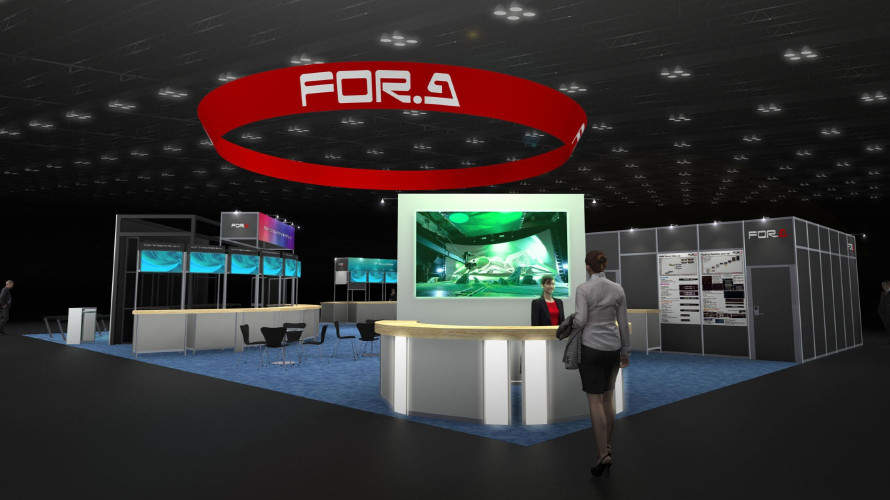BVE 2012 in no particular order.......

Author: Bob Pank#
Published 1st April 2012
The big story at BVE 2012 was BVE 2013. With the Earls Court exhibition site scheduled for redevelopment, BVE relocates next year to the ExCel exhibition site in London’s Docklands. The distance is only about 10 miles but, in the minds of many BVE exhibitors, the move is comparable with moving the NAB Convention to the Mississippi Delta.
If you read TV-Bay regularly, you will already be aware of the main trends in video and audio product development. BVE 2012 reflected these very accurately, notably the ongoing transition to file-based content capture and the growing interest in compact cameras. A good way to identify hot new products at any trade event is to identify which stands are attracting the biggest flock of visitors. Let’s look at some of the key BVE crowd-pullers.
AJA exhibited its new Io XT Thunderbolt-enabled video interface. This connects to a Thunderbolt-enabled Apple computer via a single cable. An additional Thunderbolt port is provided, enabling users to daisy-chain other Thunderbolt peripherals. The Io XT supports capture and playback of 4:2:2 and 4:4:4 HD and SD formats and incorporates 10-bit realtime up/down/cross conversion.
Blackmagic continue to provide endless solutions and BVE saw the new ATEM 2 Broadcast Panel.
The panel combines with the Atem 2 Switcher to deliver up-to 16 video inputs, 6 Aux outputs, SDI, HDMI and analogue program outputs, SDI and HDMI multi-view outputs, USB 3.0 as well as down converted SDI and composite outputs. The DVE engine is very powerful with 3D borders, light source and drop shadow. Operators can use the DVE for transitions, or route into any of the 4 built in keyers for incredible multi-layer compositions.
Camera Corps introduced a presettable version of its Q-Ball robotic camera head. Q-Ball Pre-Set allows rapid capture and recall of pan, tilt, zoom and focus data. Designed for remote operation via Camera Corps' PTZF switcher and joystick control unit, it can store up to 18 system configurations, enabling an operator to switch the head quickly from one to setting to another. Stored data is held in non-volatile RAM within the head and therefore retained even after a system is powered down between sessions. Like the established Q-Ball, Q-Ball Pre-Set is an ultra-compact remotely-controlled camera with integral 10-times zoom optical lens and smooth-accelerating pan/tilt motors.
Canon's new EOS C300 attracted a hornet’s nest of visitors. Only slightly larger than a standard digital single-lens reflex camera, it has a 4 x 2K Super 35 millimetre CMOS sensor allowing video recording at 50 megabits per second in 4:2:2 MPEG-2 MXF file format onto dual Compact Flash memory cards. A third memory slot accommodates an SD card to store user presets. The C300 is claimed to deliver low-noise images at up to ISO 20,000 sensitivity. Supporting accessories include five new lenses.
Cel-Soft’s new Reel-Check Solo-QC analyser allows a complete set of quality-control tests to be performed on live or file-based video and audio. Designed to run on a standard desktop PC or workstation, it is compatible with all signal standards and media file-types currently in common use, including webcast, broadcast and 444 digital-film formats up to 4K. Automated video test capabilities include gamut, field dominance/reversal, average picture level, blocking artifacts, stuck frames, odd frames, blank frames, noise, focus, horizontal blanking, aspect ratio, colour balance, timecode discontinuity, interlace presence, contrast, picture shift, pixel format and (optionally) PSE photosensitive epilepsy flashing.
Eyeheight announced the world's first multi-rate stereoscopic 3D colour corrector. Designed for use in broadcast production, post-production and playout centres, the CC-3D allows both channels of a stereoscopic 3D pair to be corrected under common single control. Using a common single control ensures that any adjustments made have an identical effect on both channels of a stereoscopic 3D pair. The CC-3D is capable of working at 1080i/50/59.94 or 1080p 23.976/24/25/29.97 high definition, 720p/50/59.94 intermediate definition and 625/50 or 525/59.94 standard definition.
For-A exhibited its HVS-4000 compact vision switcher. Available with 2, 2.5 or 3 mix/effects channels, it supports mixed SD, HD and 3 gigabit per second inputs, video files and stereoscopic 3D. It also offers 2.5D and 3D DVE, a built-in 4/10/16-split multiviewer and external device control. Other features include a choice of four control panels, a maximum of 48 inputs and 24 outputs and an up/down/cross converter allowing cutting between most asynchronous SD and HD input formats.
BVE 2012 saw a strong line up of professional vision mixers on Holdan’s stand. Three new models on show all have broadcast credentials but take different approaches to design and features. Datavideo’s SE-3000 is a dedicated mixer, with up-to 16 HD-SDI inputs. It has HD up-conversion of 8 sources and a 7” touch screen interface for colour adjustment, menu navigation and keying. As with all Datavideo products, the emphasis is on established values of rugged build, dependable performance and the essential features producers really need, such as first class 3D DVE and TV-quality
Ianiro demonstrated the new Libec Swift Jib50 camera jib which has a telescopic arm. The Jib50 can hold a 10 kilogramme load at 1.9 metre maximum extension or 20 kilogrammes at 1 metre. Claimed setup time is around 5 minutes on a Libec T102 tripod and DL-88 dolly. Price of the Jib50 is £1,895.
JVC showed its GY-HMQ10 8 megapixel camcorder which is claimed to be world's first handheld camcorder capable of capturing and recording real-time 8 megapixel (3840 x 2160) video at 24p, 50p and 60p. The 8 megapixel display resolution is increasingly viewed as a bridge format to NHK’s proposed 32 megapixel ultra-high-definition format. An additional reason for promoting higher screen resolution than 2 megapixels is to offset the loss in horizontal resolution likely to occur if autostereoscopic screens ever become popular for 3D viewing. The GY-HMQ10 has an f/2.8 10x zoom lens and high speed 12.5 mm CMOS imager with 8.3 million active pixels capable of capturing live progressive images at up to 60 frames per second. It also records full HD (1920 x 1080) at 50/60p or 50/60i onto a single memory card in the AVCHD format.
Newtek displayed its new TriCaster 450 series 14-channel live HD video production switcher which allows four-source multi-format video recording and incorporates a virtual set generator. A single operator or small team can switch between multiple cameras, virtual inputs and live virtual sets, while inserting clips, titles and motion graphics with multi-channel effects.
Nikon's new D4 DSLR attracted a lot of interest. It is capable of recording 1920 x 1080 video 30, 25 and 24 frames per second including stereo audio. Movie clips can be close to 30 minutes in duration. Full HD (1080p) recording is possible in both FX and DX based formats as well as in native Full HD (1920x1080) crop. Uncompressed live HD video can be output to external recorders and monitors (claimed to be the first time this has been possible in an SLR camera).
NTP promoted its Penta 725 IP audio router which eliminates the need to lease expensive dedicated telco lines traditionally used to carry audio from a regional radio or television studio back to a central location. It allows a high quality audio routing network to be operated using low-cost Gigabit IP based Ethernet lines. Controlled via NTP’s VMC software, the Penta 725 IP allows city-wide, country-wide or global routing of high quality audio with sub-millisecond timing accuracy. Penta 725 IP systems can be combined to handle a total of 512 channels on a 1 gigabit/s network. Larger systems can be integrated where greater network capacity is available. Each audio channel can be deployed as router input/output connections or to connect with extra Penta 725 IP units.
PAG’s PAGlink is claimed to be the only camera battery system that allows batteries to be linked together in multiples. Up to eight batteries can be linked, combining capacities for longer camera run-time, and delivering up to 12 amperes. The linked batteries form a serial network that controls discharging and allows charging to take place while the batteries are linked. The PL16 charger is capable of supplying 6 amperes at 16.8 volts.
Panasonic showed its new HDC-Z10000, an integrated twin-lens 2D/3D camcorder compatible with the AVCHD 3D/Progressive standard. This standard uses multiview video coding to record and play 3D images via the frame sequential method (each frame being at full resolution). The HDC-Z10000 incorporates Panasonic's double 3MOS images and f/1.5 lenses for 1920 x 1080 50 frames per second recording. It has a 1.15 megapixel 3.5-inch autostereoscopic LCD viewfinder which can be used in mix overlay mode, allowing focus to be achieved by using the left eye only. The display can also be switched between 2D and 3D. The lenses allow from 32 mm (35 mm equivalent) wide-angle shooting (29.8 mm for 2D) to 10x optical zooming (12x for 2D shooting, 23x for shooting with zoom). Three independent manual rings allow fine adjustment of focus, zoom and iris.
Preco chose BVE 2012 for the UK launch of the Logitek ROC audio control console. Designed for use in live control rooms, post-production rooms and news booths, the ROC is a modular system with a low-profile control panel which can be placed directly onto an existing worksurface. Available in 6, 12, 18 and 24 fader configurations, the console is easily integrated into permanent or temporary studios. The ROC control surface includes high-quality 100 millimetre long-throw Penny & Giles faders, OLED source indicators and meters, plus a suite of controls to maximise the power of Logitek’s JetStream audio-over-IP platform. A durable reverse-printed overlay ensures that none of the printing will be worn off by surface abrasion.
Roland exhibited its new low-cost VR-3 portable video and audio mixer which incorporates preview monitors and a streaming-ready USB output. It allows web streaming by simply connecting to a computer running a live streaming service such as Ustream or Livestream. Operating from mains or battery, it has three composite video inputs and one composite/PC switchable input plus four mono (XLR) or two stereo audio channels. Video effects include keying, split screen, picture-in-picture.
Rosco shows its new LitePad HO (high output) series of production lights. Claimed to be 33 per cent brighter than the original LitePad, these are available in daylight colour temperature (6000 degrees Kelvin) at eight standard sizes ranging from 3 x 6 inch to 24 x 24 inch rectangular and 3 inch or 12 inch circular. Each LitePad HO is 8 mm thick and operates from 12 volts direct-current. Example prices are £156 (6 x 6 inch) or £422.40 (12 inch circular).
Screen Subtitling Systems exhibited its new ScreenConnect system which can be used to assemble a television service for multiple distribution platforms, including the navigation structure and the definition of content panels across that service. A browser-based tool is used to edit and manage content with flexible control of content display. ScreenConnect handles the variation in HTML-based platforms and delivers applications through its ConnectWriter module.
Sienna demonstrated what it claims is a new concept in media preparation for video on demand. Its Active Logging system allows rapid processing of live events into edited and encoded VOD streams ready for random access replay through catch-up services. Recording, editing and playout to the media encoder all happen during the original live performance. Where material such as commercials is removed, the whole process can be synchronised to conclude very shortly after the end of the show.
Sonifex’ announced the Redbox RB-VHDDD8 Dolby E and Dolby Digital decoder and extractor. It extracts 16 channels of audio within any audio group of an SDI video signal and a further two which are sent to the Dolby decoder. Up to 10 channels from the decoder or any of the 16 channels from the de-embedder can then be re-embedded onto either of the two SDI outputs and also transmitted on a BNC or D-type situated on the rear panel.
Sony exhibited, among a lot of other things, its HDC-2500L 3-CCD HD portable and studio configurable camera. The HDC-2500 has multi-format capability, from 1080/100i (double speed) to 1080/50P, as well as 1080/50i, 1080/25P and 1080/24P. Newly developed 2/3-inch CCDs and a new digital signal processor with 16 bit A/D converter are incorporated. The side panel can be replaced to allow HD wireless or triax transmission.
Summary
That’s a short snapshot of a buoyant and expanding regional show. Yes, there was 3D kit on display but not in sufficient quantity to suggest that 2D is about to be knocked off its perch. 3D will obviously become a serious element of television broadcasting at some point in the future but whether that means five years, ten years or longer is anybody’s guess. Meanwhile, most humans get by pretty well with standard-issue context-based 2D to 3D conversion: if you see a 2D cowboy and a 2D mountain, the cowboy is probably in the foreground.



